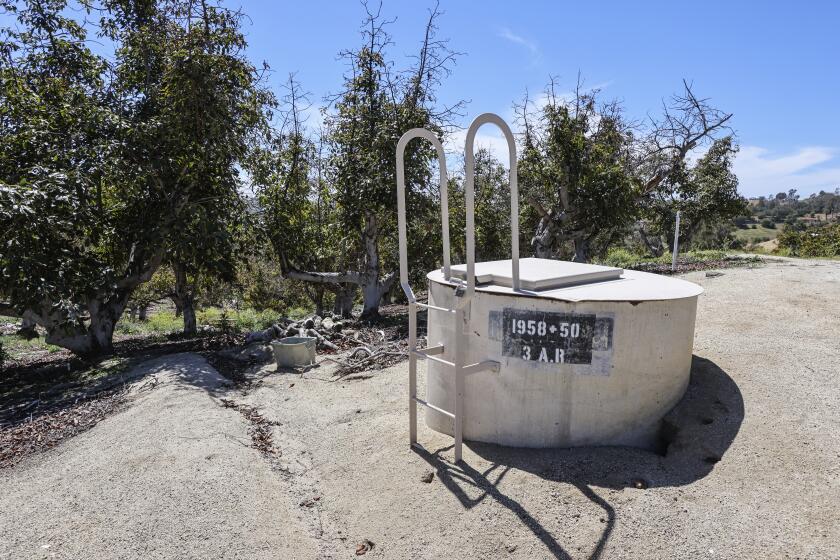AWOL leopard sharks return to La Jolla Shores
Leopard sharks that took a hiatus from La Jolla Shores this summer are finally back at the beach now that water temperatures have dropped.
The harmless, colorful fish are a popular draw each year for snorkelers, divers and kayakers in the waters off La Jolla. The sharks normally start congregating in June across from The Marine Room restaurant but this year had been missing from their usual haunt.
Andy Nosal, a marine biologist with Scripps Institution of Oceanography who studies shark behavior and ecology, said he doesn’t remember a summer in the past decade in which the sharks were so scarce for so long.
“Certainly there were days here and there, even a week here or there, where the sharks were scarce during the summer, but this year it was over two months,” he said.
With distinctive black and tan markings, leopard sharks grow 4 to 5 feet long and feed on squid, fish, clams and worms. They typically swim fin to fin on the ocean bottom each summer and are easily seen in neck-deep shallows offshore.
As of a week ago, however, even Nosal and his team weren’t finding them in the unusually warm, murky waters off the La Jolla coast.
“We were fishing all summer up to that point and had only caught one or two sharks the whole summer, which was unheard of for me,” he said.
Shane McCoy, general manager of La Jolla Kayak, said the shop normally offers snorkel tours specifically devoted to leopard sharks but had to cancel those tours earlier this summer.
“We’ve actually been talking a lot about it, because we typically see (the sharks) in pretty good numbers over the summer,” he said. “But up until now ... they’ve been missing.
Most likely, the sharks’ travel patterns changed in response to the weather, Nosal said. It appears that the animals had spread out across the coastline as ocean water temperatures rose across Southern California.
“I think that because the water was warm everywhere, the spot at La Jolla wasn’t as special,” he said. “So the sharks weren’t concentrated at what is usually the warm spot along with coast.”
Last week, the water cooled and cleared, Nosal said, and the sharks regrouped in their usual spot. McCoy said that’s good news for him and his customers.
“I grew up here, and every year it was guaranteed you would see dozens of sharks in front of The Marine Room, so we’re glad to have them back,” he said.
Ocean temperatures throughout the region were in the mid-70s through the middle of August, rising as high as 77 degrees Fahrenheit at Scripps Pier, Nosal said.
Normally at this time of year, ocean water stays in the high 60s to low 70s, he said, with La Jolla Shores rising just a few degrees more than elsewhere because of its unique topography.
That warmth appears to attract leopard sharks in the summer, he said.
Sharks are ectothermic, meaning their body temperature fluctuates with their surroundings. The leopard sharks assembled near La Jolla are pregnant females, he said, and rely on those few extra degrees to hasten gestation.
“They actually are incubating their fetuses to keep them warm,” he said. “That speeds up embryonic development, cell division, all those things, so the gestation period is actually shortened.”
Female leopard sharks bear about 20 live pups, each about the size of a Snickers bar, Nosal said. At La Jolla Shores, the expectant mothers warm up during the day and fish for squid in the underwater La Jolla Canyon at night. Recently, however, warm water has been everywhere.
Starting in 2013, extraordinary atmospheric conditions heated a large swath of the Pacific by several degrees, said Art Miller, head of the oceans and atmosphere section at Scripps Oceanography.
“The warm water we’ve been feeling the last two or three years was an expansive patch a thousand miles wide and thousands of miles long along our coast,” he said. “It was an amazing thing that it was so persistent and so large.”
Over the past week, however, northerly winds churned up deep, cold water off Southern California, chilling a strip along the coastline by 12 degrees Fahrenheit in a matter of days.
With water conditions back to normal late last week, Nosal said he and his research team caught seven sharks in two days.
The sharks are usually easy to see through September and linger until October or November, he said. So there’s still time for beachgoers to swim with the sharks.
“If water temperatures remain seasonable, that is normal, between 68 and 72 degrees, then we’ll expect to see the leopard sharks for the next couple months,” he said. “If the water temperature creeps up again, then we’ll see conditions that we saw earlier this summer.”
deborah.brennan
@sduniontribune.com






